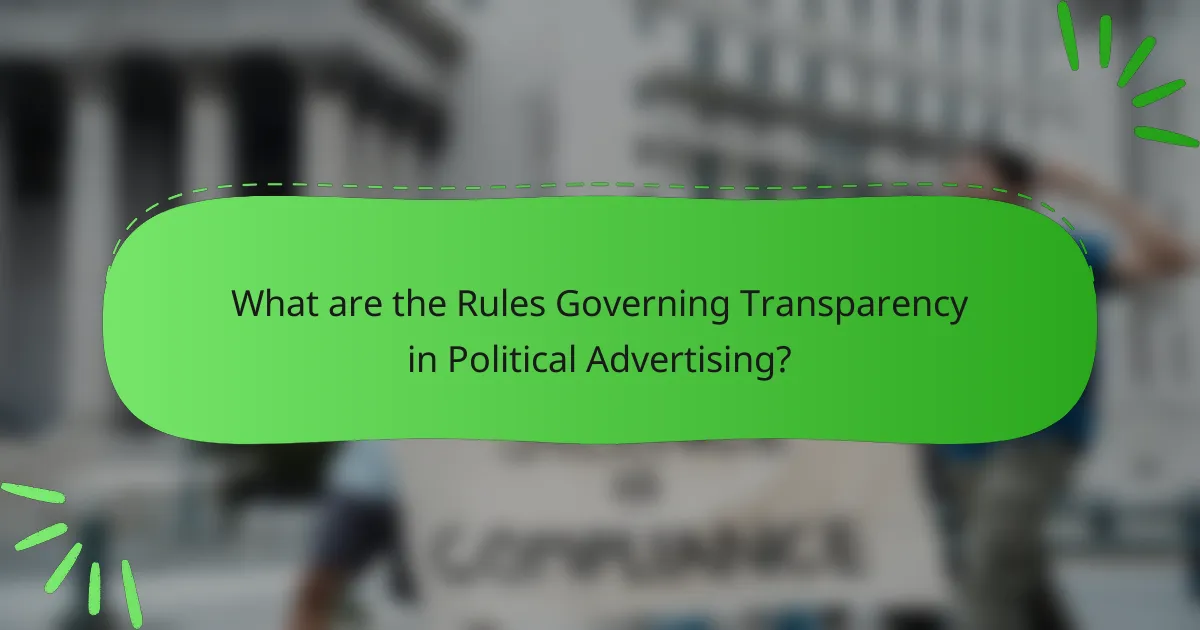Transparency in political advertising is essential for fostering public trust and ensuring informed voting decisions. This article examines the significance of transparency, highlighting how clear disclosure of funding sources helps prevent misinformation and promotes accountability among political actors. It outlines the regulations governing transparency, including federal and state laws that mandate the identification of sponsors in advertisements. Additionally, the role of the Federal Election Commission (FEC) in enforcing compliance and the impact of transparency on public trust in the electoral process are discussed. Overall, the article emphasizes that transparency is a foundational element for a healthier democratic system.

What is the Importance of Transparency in Political Advertising?
Transparency in political advertising is crucial for maintaining public trust. It ensures that voters receive accurate information about candidates and issues. This clarity helps to prevent misinformation and manipulation. Research shows that transparent advertising can lead to more informed voting decisions. According to a study by the Pew Research Center, 70% of voters consider transparency vital for fair elections. Furthermore, transparency fosters accountability among political actors. When voters understand who is funding advertisements, they can better assess potential biases. Thus, transparency in political advertising promotes a healthier democratic process.
Why is transparency crucial in political advertising?
Transparency is crucial in political advertising because it fosters trust between candidates and voters. When voters understand who is funding advertisements, they can better assess the motivations behind the messages. Transparency helps to prevent misinformation and manipulation by revealing the sources and intentions of political messages. Studies have shown that transparent campaigns are associated with higher voter engagement and trust. For example, a 2020 Pew Research study found that 71% of Americans believe knowing the source of funding for political ads is important for informed voting. This trust is essential for a healthy democratic process. Without transparency, voters may feel misled or skeptical, undermining the electoral system.
What historical events highlight the need for transparency?
The Watergate scandal highlights the need for transparency in government. This event involved a break-in at the Democratic National Committee headquarters in 1972. Subsequent cover-ups by the Nixon administration led to widespread public distrust. The scandal resulted in President Nixon’s resignation in 1974. It emphasized the importance of accountability in political actions. The Iran-Contra affair further demonstrated the necessity for transparency. This involved secret arms sales to Iran to fund Contra rebels in Nicaragua during the 1980s. Congressional investigations revealed significant government deception. These events underscore the critical role of transparency in maintaining public trust in political processes.
How does transparency influence voter trust and engagement?
Transparency significantly enhances voter trust and engagement. When political advertising is clear and open, voters feel more informed. This leads to increased confidence in the electoral process. Research shows that 70% of voters prefer candidates who provide transparent information. Transparency reduces misinformation and fosters a sense of accountability among candidates. Voters are more likely to participate when they trust the information presented. Studies indicate that transparent campaigns can increase voter turnout by up to 15%. Therefore, transparency is crucial for fostering a healthy democratic environment.
What are the key principles of transparency in political advertising?
The key principles of transparency in political advertising include clear disclosure of funding sources, identification of sponsors, and truthful representation of information. Clear disclosure ensures that voters know who is financing the advertisements. Identification of sponsors allows the public to understand the motivations behind the messages. Truthful representation of information prevents misleading claims. These principles aim to promote accountability and trust in the political process. Research indicates that transparency enhances voter engagement and informed decision-making. According to the Federal Election Commission, transparency in political advertising is essential for a healthy democracy.
What specific attributes define transparency in this context?
Transparency in political advertising is defined by clarity, accessibility, and accountability. Clarity ensures that the information presented is straightforward and easily understood. Accessibility means that the information is readily available to the public, allowing citizens to engage with it. Accountability refers to the obligation of advertisers to take responsibility for the content they produce. These attributes promote informed decision-making among voters. Research shows that transparent political advertising increases trust in the electoral process. According to a study by the Pew Research Center, 70% of voters value transparency in campaign communications.
How do these principles apply to different types of political ads?
Political advertising principles emphasize transparency, accuracy, and accountability. These principles apply to various types of political ads, including broadcast, digital, and print. For broadcast ads, regulations require clear identification of sponsors. This ensures viewers understand who is funding the message. Digital ads must also reveal funding sources, especially on social media platforms, to combat misinformation. Print ads are subject to similar disclosure requirements to maintain credibility. Additionally, all political ads must avoid false claims to uphold integrity. Violations can lead to penalties, reinforcing the need for adherence to these principles. Thus, transparency is crucial across all formats to foster trust and informed decision-making among voters.

What are the Rules Governing Transparency in Political Advertising?
The rules governing transparency in political advertising require clear disclosure of funding sources. Advertisements must identify the organization or individual financing them. This ensures voters understand who is behind the messages they receive. Federal law mandates that political ads include a “paid for by” statement. Many states have additional requirements for transparency in campaign financing. For instance, some jurisdictions require detailed reporting of contributions and expenditures. These regulations aim to prevent misleading information and promote accountability. Studies show that transparency can increase public trust in political processes.
What regulations exist to ensure transparency in political advertising?
Regulations ensuring transparency in political advertising include the Federal Election Commission (FEC) rules in the United States. These rules require disclosure of funding sources for political ads. Advertisements must clearly identify the sponsor. The “Bipartisan Campaign Reform Act” mandates reporting of contributions and expenditures. Additionally, many states have their own laws governing political ad transparency. These laws often require disclosure of the ad’s funding and sponsor information. Transparency regulations aim to inform voters about who is behind political messaging. Studies show that transparency enhances voter trust and engagement in the electoral process.
Which governmental bodies enforce these regulations?
The Federal Election Commission (FEC) enforces regulations related to political advertising in the United States. The FEC is an independent regulatory agency. It oversees campaign finance laws and ensures compliance with transparency requirements. Additionally, state election offices may enforce local regulations. These bodies monitor political advertisements for accuracy and disclosure. They investigate violations and impose penalties when necessary. The FEC’s role is crucial in maintaining fair election practices.
What are the penalties for non-compliance with these rules?
Penalties for non-compliance with political advertising rules can include fines, legal action, and potential criminal charges. Regulatory bodies may impose monetary fines that vary based on the severity of the violation. For instance, fines can range from hundreds to thousands of dollars. In some cases, repeated violations may lead to increased penalties. Legal action can result in court orders to cease advertising practices. Criminal charges may apply for severe infractions, leading to possible imprisonment. These penalties aim to enforce compliance and maintain transparency in political advertising.
How do these rules vary across different jurisdictions?
Rules regarding political advertising transparency vary significantly across jurisdictions. In the United States, federal laws require disclosure of funding sources for political ads. However, individual states can impose additional regulations, leading to a patchwork of rules. For instance, California mandates stricter disclosure requirements compared to Texas. In Europe, the European Union enforces regulations that require clear labeling of political ads, while individual countries may have their own specific rules. This variation can affect the level of transparency and accountability in political advertising. The differences are influenced by local political cultures, historical contexts, and the legal frameworks established in each jurisdiction.
What unique attributes exist in state-level regulations?
State-level regulations have unique attributes that differentiate them from federal laws. One attribute is the variation in disclosure requirements for political advertising. Different states impose diverse standards on what must be disclosed to the public. Another unique attribute is the specific enforcement mechanisms established by each state. Some states have dedicated agencies for oversight, while others rely on existing regulatory bodies. Additionally, states may have different thresholds for campaign contribution limits. This can affect how much individuals or entities can donate to political campaigns. Lastly, the definitions of “political advertising” can vary significantly across states. These differences can lead to inconsistencies in how transparency is achieved in political advertising.
How do international standards compare to local rules?
International standards often prioritize transparency and accountability in political advertising. Local rules can vary significantly in their strictness and enforcement. For example, some countries may have comprehensive regulations aligned with international guidelines, while others may lack specific laws. International standards provide a framework for best practices, whereas local rules may be influenced by cultural and political contexts. This can lead to discrepancies in how political advertising is regulated. Studies show that adherence to international standards improves public trust in electoral processes. Therefore, the comparison highlights the need for alignment between local rules and international expectations to enhance transparency.

How is Transparency in Political Advertising Enforced?
Transparency in political advertising is enforced through regulations set by government agencies. In the United States, the Federal Election Commission (FEC) oversees compliance with advertising laws. Political advertisements must disclose the source of funding. This includes identifying the sponsor of the advertisement. Failure to comply can result in fines or legal action. Various states also have specific laws to enhance transparency. For example, some require additional disclosures about funding sources. Monitoring organizations track compliance and report violations. Reports from these organizations can lead to investigations by regulatory bodies.
What mechanisms are in place for monitoring compliance?
Monitoring compliance in political advertising involves several mechanisms. These include regulatory oversight by government agencies, such as the Federal Election Commission (FEC) in the United States. The FEC enforces rules regarding the disclosure of campaign finance information. Additionally, independent watchdog organizations monitor advertising practices and report violations.
Another mechanism is the requirement for political ads to include disclaimers identifying sponsors. This promotes transparency and accountability. Furthermore, states may have their own laws and agencies to enforce compliance with advertising regulations. These mechanisms work collectively to ensure adherence to established rules in political advertising.
How do watchdog organizations contribute to enforcement?
Watchdog organizations contribute to enforcement by monitoring compliance with political advertising regulations. They investigate potential violations and gather evidence of misconduct. These organizations often publish reports detailing their findings. They provide transparency by making information accessible to the public. Watchdog groups also engage in advocacy for stricter enforcement measures. They may collaborate with regulatory agencies to enhance oversight. Their efforts help hold political entities accountable for their advertising practices. This accountability is crucial for maintaining public trust in the electoral process.
What role do technology and data play in monitoring advertising?
Technology and data are essential for monitoring advertising effectiveness and compliance. They enable real-time tracking of ad performance across multiple platforms. Advanced analytics tools assess engagement metrics, such as clicks and impressions. Data-driven insights help advertisers optimize their campaigns for better reach and impact. Additionally, technology facilitates the identification of fraudulent activities, such as bot traffic. Automated systems can flag suspicious patterns in ad spending. Furthermore, regulatory compliance is enhanced through data transparency. This ensures that political advertisements adhere to established guidelines and laws. According to a report by the Pew Research Center, 70% of marketers use data analytics to improve their advertising strategies. This demonstrates the critical role of technology and data in modern advertising practices.
What challenges exist in enforcing transparency in political advertising?
Challenges in enforcing transparency in political advertising include the complexity of regulations. Many jurisdictions have varying rules, making compliance difficult. Additionally, the rapid evolution of digital platforms complicates monitoring efforts. Advertisers can easily obscure their identities through tactics like using third-party organizations. This lack of clarity can hinder accountability. Furthermore, enforcement agencies often lack adequate resources to investigate all potential violations. The political nature of advertising also leads to resistance from stakeholders who may oppose transparency measures. These factors collectively create significant barriers to effective enforcement.
How do loopholes in regulations affect enforcement?
Loopholes in regulations undermine enforcement by creating gaps that can be exploited. These gaps allow entities to circumvent compliance without facing penalties. For instance, political advertisers may exploit vague language to avoid disclosure requirements. This leads to a lack of accountability in political advertising. According to the Federal Election Commission, such loopholes can result in millions of dollars in undisclosed funding. The absence of clear guidelines diminishes the effectiveness of regulatory bodies. Consequently, enforcement efforts become inconsistent and less effective. Overall, loopholes significantly weaken the intended impact of regulations.
What are the implications of digital advertising on enforcement efforts?
Digital advertising significantly complicates enforcement efforts in political advertising. The rapid dissemination of information online makes it challenging to monitor compliance with advertising regulations. Additionally, the use of targeted ads can obscure the source and funding of political messages. This lack of transparency can hinder regulatory bodies from effectively enforcing existing laws. For instance, the Federal Election Commission has noted difficulties in tracking digital ad spending due to the evolving landscape of online platforms. Furthermore, the anonymity provided by digital channels can facilitate misinformation and deceptive practices. These factors collectively undermine the integrity of political advertising and complicate enforcement efforts.
What best practices can political advertisers adopt for transparency?
Political advertisers can adopt several best practices for transparency. They should disclose funding sources for their advertisements. This includes identifying individuals or organizations that provide financial support. Advertisers must clearly label sponsored content. This helps audiences distinguish between paid advertisements and organic content.
Additionally, they should provide detailed information about the target audience. This includes demographics and geographic data for ad placements. Transparency in data collection practices is also essential. Advertisers should inform audiences about how their data is used.
Furthermore, they can publish regular reports on ad spending. This includes how much is spent and on what platforms. Engaging with fact-checkers can enhance credibility. This practice helps verify claims made in advertisements.
These practices align with regulations set forth by the Federal Election Commission. Compliance with these rules fosters trust with the electorate. Transparency ultimately enhances the integrity of political advertising.
How can political campaigns ensure compliance with transparency rules?
Political campaigns can ensure compliance with transparency rules by implementing rigorous reporting practices. They should maintain accurate records of all contributions and expenditures. Regular audits can help verify financial activities. Campaigns must disclose the sources of funding transparently. They should also adhere to deadlines for filing financial reports. Utilizing compliance software can streamline the reporting process. Training staff on transparency regulations is crucial for adherence. Following these practices can significantly reduce the risk of violations.
What tools and resources are available to enhance transparency in advertising?
Tools and resources that enhance transparency in advertising include disclosure regulations, ad libraries, and third-party verification services. Disclosure regulations require advertisers to provide clear information about sponsored content. Ad libraries, such as the Facebook Ad Library, allow users to view active and inactive ads. Third-party verification services, like the Media Rating Council, help ensure compliance with advertising standards. These tools promote accountability and enable consumers to make informed decisions about the ads they encounter.
The main entity of the article is transparency in political advertising. The article emphasizes the importance of transparency for fostering public trust, preventing misinformation, and promoting accountability among political actors. It outlines key principles of transparency, including clear disclosure of funding sources and truthful representation of information. Additionally, it discusses the rules governing transparency, the role of regulatory bodies like the Federal Election Commission, and the challenges faced in enforcing these regulations. The article also highlights best practices for political advertisers to enhance transparency and compliance with advertising rules.